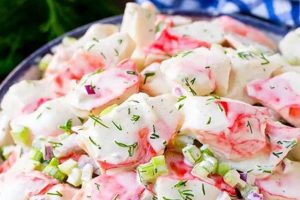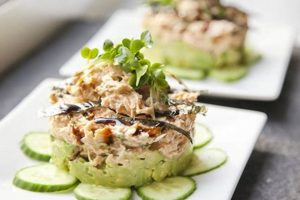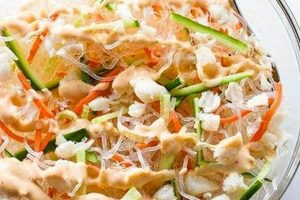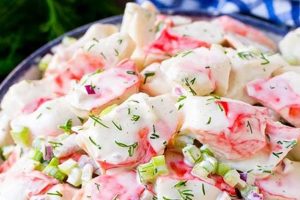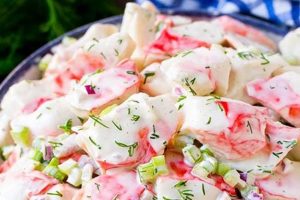A classic American dish, this salad typically features Dungeness or king crab meat arranged over crisp lettuce with a creamy, tangy dressing. Common additions include tomatoes, hard-boiled eggs, cucumbers, and asparagus. Variations exist, incorporating ingredients like avocado, olives, or different types of lettuce. A typical dressing often blends mayonnaise, chili sauce, lemon juice, Worcestershire sauce, and seasonings.
This salad’s enduring popularity stems from its refreshing combination of textures and flavors. The sweet, delicate crab meat complements the crunchy vegetables and rich dressing, creating a balanced and satisfying meal. Originating on the West Coast of the United States in the early 20th century, its historical ties to San Francisco and Seattle solidify its status as a regional culinary icon. The dish offers a relatively light yet protein-rich option, appealing to those seeking a flavorful and nutritious meal.
Exploring the various approaches to preparing this dish offers a fascinating glimpse into culinary creativity. From traditional preparations to modern interpretations, the following sections will delve into specific ingredient choices, dressing variations, and plating techniques that contribute to the perfect rendition of this celebrated salad.
Tips for an Exceptional Crab Louie Salad
Achieving optimal flavor and presentation requires careful consideration of several key elements. The following tips offer guidance for elevating this classic dish.
Tip 1: Crab Selection: Opting for high-quality, fresh crab meat is paramount. Dungeness and king crab are traditional choices, offering sweet and delicate flavors. Pasteurized crab meat provides a convenient alternative, but fresh crab, when available, yields superior results.
Tip 2: Dressing Consistency: The dressing should be thick enough to coat the ingredients without being overly heavy. Achieving the proper balance of mayonnaise, chili sauce, and other components ensures the desired creamy texture and tangy flavor.
Tip 3: Vegetable Crispness: Utilizing crisp, fresh vegetables enhances the salad’s textural appeal. Washing and thoroughly drying lettuce and other vegetables prevents a soggy salad. Chilling the vegetables before assembling the salad also contributes to their crispness.
Tip 4: Egg Preparation: Perfectly cooked hard-boiled eggs are essential. Overcooked yolks can become dry and crumbly. Proper timing and immediate cooling in ice water help achieve ideal yolk texture and prevent discoloration.
Tip 5: Ingredient Balance: A harmonious blend of flavors and textures distinguishes a truly exceptional salad. Balancing the richness of the crab and dressing with the acidity of the lemon juice and the crispness of the vegetables is key.
Tip 6: Plating Techniques: Thoughtful presentation elevates the dining experience. Arranging the crab meat attractively over the bed of lettuce and strategically positioning other elements creates visual appeal.
Tip 7: Seasoning Adjustments: Tasting and adjusting seasonings throughout the preparation process allows for customization according to individual preferences. A pinch of salt, pepper, or a dash of hot sauce can enhance the overall flavor profile.
By adhering to these guidelines, one can ensure a delicious and visually appealing crab Louie salad. Attention to detail, from ingredient selection to final presentation, contributes to a truly satisfying culinary experience.
With these tips in mind, the following section will explore several variations on this classic recipe, demonstrating the versatility and adaptability of this beloved dish.
1. Fresh, High-Quality Crab
The foundation of an exceptional crab Louie salad rests upon the selection of fresh, high-quality crab meat. This ingredient dictates the overall flavor profile and contributes significantly to the dish’s success. Understanding the nuances of crab selection is essential for achieving optimal results.
- Impact on Flavor:
Fresh crab offers a delicate sweetness and subtle brininess that complements the other salad components. Frozen or canned crab, while convenient, often lacks the nuanced flavor of fresh crab, potentially diminishing the overall culinary experience. The natural sweetness of fresh crab allows the other flavors in the salad, such as the tangy dressing and crisp vegetables, to shine without being overpowered.
- Textural Considerations:
Fresh crab meat possesses a delicate, flaky texture that contrasts pleasingly with the crisp vegetables and creamy dressing. Overly processed or improperly handled crab can become tough or mushy, detracting from the desired textural balance. The firm yet tender texture of high-quality crab provides a delightful contrast to the crunch of lettuce and other vegetables.
- Species Selection:
While Dungeness and king crab are traditional choices for crab Louie salad, other varieties like blue crab or stone crab can offer unique flavor profiles and textures. Understanding the characteristics of each species allows for informed decision-making and customization of the salad. Dungeness crab, known for its sweet and delicate flavor, is a popular choice, while king crab offers a richer, more robust taste.
- Sourcing and Handling:
Proper sourcing and handling are crucial for maintaining freshness and quality. Purchasing crab from reputable suppliers and ensuring proper refrigeration are essential steps. If using live crab, careful cooking and cleaning techniques are necessary to extract the meat while preserving its integrity. Proper handling minimizes the risk of bacterial contamination and ensures food safety.
Ultimately, the quality of the crab directly influences the overall quality of the crab Louie salad. Prioritizing fresh, high-quality crab meat elevates this classic dish from satisfactory to exceptional. Investing in premium crab enhances the dining experience, justifying the extra effort and expense.
2. Crisp Vegetables
The textural interplay between the crab meat and the vegetables defines a successful crab Louie salad. Crisp vegetables provide a refreshing counterpoint to the richness of the crab and the creamy dressing. Their inclusion is not merely for aesthetic purposes; it contributes significantly to the overall sensory experience.
- Variety and Selection:
Traditional choices include iceberg lettuce, romaine hearts, and watercress. These options offer a neutral flavor profile that allows the other ingredients to shine. However, incorporating other crisp vegetables like shredded carrots, thinly sliced cucumbers, or blanched asparagus adds complexity and visual appeal. The selection should prioritize freshness and structural integrity, ensuring a satisfying crunch.
- Preparation and Handling:
Proper handling is crucial for maintaining crispness. Thoroughly washing and drying the vegetables prevents sogginess. Storing vegetables in a cool environment helps maintain their texture. For optimal results, chill the vegetables before assembling the salad. Additionally, cutting vegetables into bite-sized pieces facilitates easier consumption and even distribution throughout the salad.
- Impact on Flavor and Texture:
Crisp vegetables contribute a refreshing element that balances the richness of the crab and dressing. Their structural integrity offers a satisfying contrast to the softer textures of the other components. The slight bitterness of some greens, like romaine, can further enhance the flavor profile. This interplay of textures and flavors elevates the salad from a simple combination of ingredients to a multi-sensory experience.
- Visual Appeal and Presentation:
The vibrant colors and varied shapes of crisp vegetables enhance the visual appeal of the salad. Thoughtful arrangement contributes to an aesthetically pleasing presentation, stimulating appetite and elevating the dining experience. A well-plated salad showcases the careful selection and preparation of the vegetables, adding to the overall enjoyment of the dish.
The careful selection and preparation of crisp vegetables contribute significantly to the success of a crab Louie salad. Their role extends beyond mere texture, influencing flavor, presentation, and the overall dining experience. By understanding the importance of crispness and employing proper handling techniques, one can elevate this classic dish to new heights.
3. Balanced, Flavorful Dressing
The dressing serves as the unifying element in a crab Louie salad, binding the diverse components and influencing the overall flavor profile. A well-executed dressing enhances the inherent flavors of the crab and vegetables without overpowering them. Balance is crucial; the dressing should complement, not dominate, the other ingredients. A harmonious blend of tanginess, creaminess, and subtle spice characterizes a successful crab Louie dressing. An overly acidic dressing can mask the delicate sweetness of the crab, while an excessively rich dressing can overwhelm the palate. Classic variations often incorporate mayonnaise, chili sauce, lemon juice, Worcestershire sauce, and seasonings. The interplay of these ingredients creates a complex flavor profile that enhances the overall dining experience.
Consider the impact of individual components. Mayonnaise provides creaminess and richness, acting as a base for the other flavors. Chili sauce introduces a subtle heat and tang, adding depth and complexity. Lemon juice contributes brightness and acidity, balancing the richness of the mayonnaise and enhancing the freshness of the vegetables. Worcestershire sauce offers umami notes, further deepening the flavor profile. Finally, seasonings like paprika, salt, and pepper provide subtle nuances and enhance the overall balance. Each ingredient plays a crucial role in achieving the desired flavor profile. Real-life examples demonstrate this principle; a dressing lacking sufficient acidity can taste bland, while an excess of chili sauce can render the salad overly spicy. The interplay of these ingredients underscores the importance of precise measurements and thoughtful consideration of flavor profiles.
Understanding the delicate balance within the dressing is essential for creating a successful crab Louie salad. This knowledge allows for informed adjustments and customization based on individual preferences and ingredient availability. Challenges arise when attempting to adapt the dressing to accommodate dietary restrictions or specific flavor preferences. Substituting ingredients can alter the balance and texture, requiring careful consideration and adjustments to other components. However, with careful attention to detail and a thorough understanding of the principles of balance and flavor, one can craft a dressing that elevates the crab Louie salad from a simple dish to a culinary masterpiece.
4. Proper Egg Preparation
Proper egg preparation is essential for a well-executed crab Louie salad. Hard-boiled eggs contribute not only visual appeal but also protein and textural contrast. Incorrectly cooked eggs can detract from the overall dining experience, highlighting the importance of understanding and implementing appropriate cooking techniques.
- Timing and Technique:
Achieving the perfect hard-boiled egg requires precise timing and controlled temperature. Overcooking results in dry, crumbly yolks and a rubbery texture, while undercooking yields a runny yolk unsuitable for this salad. Methods like steaming or using an egg cooker offer greater control over the cooking process, minimizing the risk of overcooking and ensuring a consistently cooked yolk and white. A properly cooked egg will have a firm, yet tender white and a fully set, creamy yolk.
- Cooling and Peeling:
Rapid cooling in ice water immediately after cooking halts the cooking process and facilitates easier peeling. This step prevents the formation of a greenish ring around the yolk, which can occur when eggs are left to cool slowly. Furthermore, gentle tapping and rolling on a flat surface before peeling helps loosen the shell and minimize damage to the egg white. A clean, smoothly peeled egg enhances the presentation of the salad.
- Presentation and Plating:
Sliced or quartered hard-boiled eggs add visual appeal to the salad. Uniformly sized pieces create a professional look and ensure even distribution of flavor and texture. Arranging the egg wedges strategically amongst the other components enhances the overall presentation, adding a touch of elegance to the dish. Additionally, a sprinkle of paprika or a dusting of finely chopped chives can further enhance the visual appeal.
- Impact on Flavor and Texture:
Properly cooked eggs contribute a subtle, creamy flavor and a firm yet tender texture to the salad. This textural contrast complements the flaky crab, crisp vegetables, and creamy dressing. Overcooked eggs, on the other hand, offer a dry, chalky texture that detracts from the overall sensory experience. The subtle flavor of the egg enhances the other components without overpowering them, contributing to a balanced and harmonious flavor profile.
The attention to detail in egg preparation reflects a commitment to quality that extends to every aspect of the crab Louie salad. From precise timing and controlled cooling to thoughtful presentation, each step contributes to the overall success of the dish. Mastering these techniques ensures that the eggs enhance, rather than detract from, the overall culinary experience.
5. Thoughtful Presentation
Thoughtful presentation elevates the crab Louie salad from a simple meal to a dining experience. Visual appeal significantly impacts enjoyment, stimulating appetite and enhancing perceived flavor. Presentation considerations extend beyond mere aesthetics, encompassing practical elements that contribute to a more satisfying and enjoyable consumption process. Strategic arrangement of ingredients optimizes both visual impact and ease of serving and eating.
- Color and Contrast:
The vibrant hues of fresh ingredients create a visually appealing composition. The red of tomatoes, the white of hard-boiled eggs, the green of lettuce, and the pale pink of crab meat offer inherent contrast. Intentional placement of these elements maximizes visual impact. Consider the placement of vibrant green asparagus spears against the white of the egg or the red of tomato wedges nestled amongst the crab meat. This interplay of color enhances the overall aesthetic appeal.
- Texture and Height:
Varying textures and heights create visual interest and contribute to a more engaging dining experience. The flaky texture of the crab meat contrasts with the crisp lettuce and smooth egg slices. Creating height by mounding the crab meat or arranging the lettuce leaves strategically adds dimension to the presentation. Consider layering the ingredients to create a visually appealing cross-section showcasing the various textures and colors. This interplay of textures adds depth and complexity to the visual presentation.
- Plating and Garnishing:
Appropriate plating and garnishing enhance the visual appeal and signal attention to detail. Choosing plates that complement the salad’s colors and textures enhances the overall presentation. Simple garnishes, such as a sprinkle of paprika, a dusting of chopped chives, or a lemon wedge, add a finishing touch without overwhelming the dish. Avoid overcrowding the plate, allowing each element to stand out. A clean, uncluttered presentation emphasizes the freshness and quality of the ingredients.
- Practical Considerations:
Presentation also considers practical aspects of serving and consumption. Evenly distributing ingredients ensures each serving contains a balanced representation of flavors and textures. Cutting larger ingredients into bite-sized pieces facilitates easier eating. Consider individual portions versus family-style presentation based on the dining context. Thoughtful presentation enhances not only visual appeal but also the overall dining experience by making the salad easier to serve and enjoy.
Thoughtful presentation enhances the crab Louie salad experience, transforming a simple dish into a culinary delight. By considering color, texture, plating, and practical elements, one demonstrates a commitment to quality that extends beyond flavor to encompass the entire dining experience. These considerations, when applied effectively, elevate the crab Louie salad from a mere meal to a memorable culinary creation.
Frequently Asked Questions
This section addresses common inquiries regarding the preparation and enjoyment of crab Louie salad, offering clarity and guidance for both novice and experienced cooks.
Question 1: What type of crab meat is best suited for this salad?
While Dungeness and king crab are traditional and preferred choices due to their sweet, delicate flavor and tender texture, other varieties like blue crab or jumbo lump crab meat can also be used. The key is to select high-quality, fresh crab meat whenever possible for optimal flavor and texture.
Question 2: Can the dressing be prepared in advance?
Yes, the dressing can be prepared a day or two in advance and stored in an airtight container in the refrigerator. This allows the flavors to meld and deepen. However, it’s recommended to add the lemon juice just before serving to maintain its brightness and prevent the dressing from becoming too acidic.
Question 3: How can one prevent the salad from becoming soggy?
Thoroughly drying all vegetables after washing is crucial. Additionally, chilling the lettuce and other vegetables before assembling the salad helps maintain their crispness. Adding the dressing just before serving also prevents the vegetables from wilting.
Question 4: What are suitable substitutes for individuals with shellfish allergies?
While the essence of crab Louie salad lies in the crab, individuals with shellfish allergies can substitute with imitation crab meat, cooked chicken, or even hearts of palm for a vegetarian option. Adjusting the seasonings may be necessary to accommodate the different flavor profiles.
Question 5: How long can the salad be stored?
It is best consumed immediately after preparation to enjoy the optimal flavor and texture of the ingredients. However, if storage is necessary, the salad without the dressing can be stored in an airtight container in the refrigerator for up to 24 hours. Dress the salad just before serving.
Question 6: Can frozen crab meat be used?
While fresh crab meat is always preferred, frozen crab meat can be used in a pinch. Ensure it’s fully thawed and patted dry before incorporating it into the salad. Be aware that frozen crab meat may have a slightly different texture and less pronounced flavor compared to fresh crab.
Understanding the nuances of ingredient selection, preparation, and storage ensures a successful outcome when preparing this classic dish. Addressing these common queries helps eliminate potential pitfalls and empowers individuals to create a truly exceptional crab Louie salad.
The following section will offer a curated selection of crab Louie salad recipes, showcasing variations on this classic dish.
Crab Louie Salad Recipes
Exploration of crab Louie salad recipes reveals a dish steeped in tradition yet adaptable to modern interpretations. Emphasis on fresh, high-quality ingredients, balanced flavors, and thoughtful presentation underscores the potential for culinary excellence. From the careful selection of crab meat and the nuanced balance of the dressing to the proper handling of vegetables and the precision in egg preparation, each component contributes to the overall success of the dish. Understanding the interplay of these elements allows for informed choices, enabling adaptation and customization while maintaining the integrity of this classic salad.
Crab Louie salad represents more than a mere assemblage of ingredients; it embodies a culinary experience. Its enduring popularity speaks to the timeless appeal of fresh, vibrant flavors and satisfying textures. Continued exploration of variations and refinements promises to further elevate this classic dish, ensuring its place within the culinary landscape for generations to come. The potential for creative expression within the framework of this established recipe invites both culinary professionals and home cooks to engage with its rich history and explore its boundless future.

